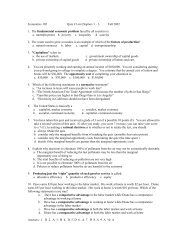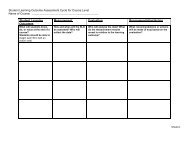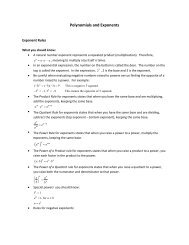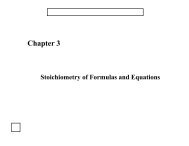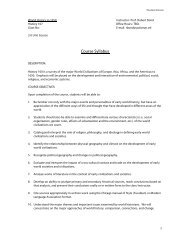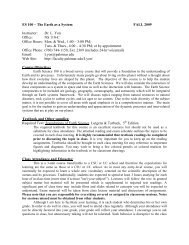Introduction to Art Temporary Course Packet - Palomar College
Introduction to Art Temporary Course Packet - Palomar College
Introduction to Art Temporary Course Packet - Palomar College
Create successful ePaper yourself
Turn your PDF publications into a flip-book with our unique Google optimized e-Paper software.
temporary<br />
This <strong>Temporary</strong> <strong>Course</strong> <strong>Packet</strong> will<br />
only get you through the first week<br />
or two of class. Buy the regular<br />
<strong>Course</strong> <strong>Packet</strong> in the books<strong>to</strong>re as<br />
soon as possible!
introduction <strong>to</strong> art temporary course packet<br />
introduction<br />
This temporary <strong>Introduction</strong> <strong>to</strong> <strong>Art</strong> <strong>Course</strong> <strong>Packet</strong> (Second Edition) was researched<br />
and produced by Professor Mark Hudelson at <strong>Palomar</strong> <strong>College</strong> in San Marcos,<br />
California (©2012). It is intended as a supplement <strong>to</strong> Kissick’s <strong>Art</strong>: Context and<br />
Criticism (Second Edition). Please purchase the COMPLETE course packet in the<br />
books<strong>to</strong>re as soon as you can.<br />
In this course packet, there are four types of materials: chapter guides, study<br />
guides, video guides and test guides.<br />
Chapter guides parallel the chapters in Kissick. In class, when your instruc<strong>to</strong>r<br />
shows you a work of art listed in a chapter guide, put a check mark by it. Now you<br />
have all of the facts about that work (its correct spelling for artist and title, its size, its<br />
material, etc.) and you can focus your note taking on the lecture. This also saves<br />
your instruc<strong>to</strong>r from having <strong>to</strong> write everything on the board.<br />
Study guides summarize major art concepts or periods. Your instruc<strong>to</strong>r may have<br />
you fill a study guide out in class or you may be assigned <strong>to</strong> fill in the answers as<br />
homework. The answers <strong>to</strong> the study guides are on my website:<br />
http://www2.palomar.edu/users/mhudelson/<br />
From my homepage, click on “<strong>Art</strong> 100” and then on “study guides.”<br />
Video guides correspond <strong>to</strong> videos you may see in class. Just answer the<br />
questions in the video guide as those points are addressed in the video. Your<br />
instruc<strong>to</strong>r may have you fill out these guides <strong>to</strong>gether in class or assign the<br />
questions as homework. The answers <strong>to</strong> the video guide questions are on my<br />
website. Again, click on “<strong>Art</strong> 100” and then on “video guides.” Many of these videos<br />
can also be found on my YouTube channel:<br />
http://www.youtube.com/arthis<strong>to</strong>ryprof<br />
Test guides provide you with terms <strong>to</strong> study for the quizzes, as well as hints on how<br />
<strong>to</strong> prepare for the midterms and final exam.<br />
All of these items (chapter, study, video and test guides) will help you in taking<br />
notes and in preparing for the tests. I hope you find this temporary course packet<br />
useful.<br />
-Prof. Mark Hudelson<br />
Page: i
introduction <strong>to</strong> art temporary course packet<br />
table of contents<br />
Chapter Guide: <strong>Introduction</strong> .............................................................................................................. 1.<br />
Chapter Guide: The Beginnings of <strong>Art</strong> .............................................................................................. 4.<br />
Study Guide: Building the Great Pyramid .............................................................................................. 8.<br />
Video Guide: Time Life’s Lost Civilizations: Egypt: Quest for Immortality ........................................... 9.<br />
Study Guide: Pyramid vs. Ziggurat ...................................................................................................... 12.<br />
Video Guide: Time Life’s Lost Civilizations: Mesopotamia: Return <strong>to</strong> Eden ....................................... 13.<br />
Page: ii
works of art and architecture<br />
chapter guide: introduction<br />
introduction<br />
the power of images<br />
1. Drummers of the Hitler Youth Movement at Nuremberg, September 1933.<br />
2. Calvin Klein advertisement, 1993.<br />
3. “Portrait drawing with ease” reproduced from Drawing on the Right Side of the Brain by<br />
Betty Edwards.<br />
viewing art as language<br />
4. addressor<br />
5. addressee<br />
6. code<br />
7. medium<br />
8. context<br />
9. medium of communication<br />
10. Mary CASSATT. The Bath. 1891. Oil on canvas, 39 1/2 x 26”.<br />
11. Grecian Urn.<br />
art and its codes<br />
12. Jan VERMEER. Woman Holding a Balance. c. 1664. Oil on canvas, 16 3/4 x 15”.<br />
13. EIZAN. Courtesan Misado of the Tama-ya (House of the Jewels). c. 1810. Oban color<br />
print.<br />
a vocabulary lesson<br />
line<br />
14. line<br />
15. Vincent VAN GOGH. Grove of Cypresses. 1889. Reed pen and ink over pencil on<br />
paper, 24 1/4 x 18 1/4”.<br />
16. texture<br />
17. proximity<br />
18. density of value<br />
19. relative darkness or lightness<br />
20. relative thickness<br />
©2012 Mark Hudelson Page: 1 Use with Kissick, 2 nd ed.<br />
= art from Kissick; = art not from Kissick; = term; underline and/or italics = title <strong>to</strong> memorize for exam
1. Henri MATISSE. Portrait of Baudelaire (plate, page 136) from Poésies de Stéphane<br />
Mallarmé, published Lausanne, Albert Skira & Cie, Oc<strong>to</strong>ber 1932. Etching, printed in black,<br />
composition 12 x 9”.<br />
2. measure<br />
3. direction<br />
4. line speed<br />
5. exterior lines<br />
6. interior spaces<br />
7. outline<br />
8. shape<br />
9. form<br />
10. Mel BOCHNER. Vertigo. 1982. Charcoal, conté crayon, and pastel on sized canvas,<br />
fixed with magna varnish, 9’ x 6’2”.<br />
11. visual his<strong>to</strong>ry<br />
12. overlaying lines<br />
value<br />
13. value<br />
14. neutrals<br />
15. Jacques VILLON. Portrait of a Young Woman (Portrait de Jeune Femme). 1913.<br />
Drypoint, printed in black, pick: 21 9/16 x 16 ¼”.<br />
16. cross-hatching<br />
17. edges<br />
color<br />
18. color<br />
19. color property<br />
20. Color wheel.<br />
21. color wheel<br />
22. Primary triad.<br />
23. primary colors<br />
24. Secondary triad.<br />
25. secondary colors<br />
26. intermediate colors<br />
27. neutralized color<br />
28. Complementary wheel with lines leading <strong>to</strong> deep gray.<br />
29. complementary colors<br />
30. hue<br />
31. value<br />
32. intensity<br />
33. normative value<br />
34. tint<br />
35. shade<br />
36. Hues on the right side of the color wheel arranged according <strong>to</strong> gradations on the gray<br />
value scale.<br />
37. saturation or chroma (purity)<br />
38. The hue red at normative value (high dark) shown in four gradations of intensity.<br />
©2012 Mark Hudelson Page: 2 Use with Kissick, 2 nd ed.<br />
= art from Kissick; = art not from Kissick; = term; underline and/or italics = title <strong>to</strong> memorize for exam
harmonies and discords<br />
1. harmony<br />
2. Berthe MORISOT. La Lecture (Reading). 1888. Oil on canvas, 29 1/4 x 36 1/2”.<br />
3. monochromatic<br />
4. Vincent VAN GOGH. Night Café. 1888. Oil on canvas, 28 1/2 x 36 1/4”.<br />
5. complementary<br />
6. analogous<br />
7. Henri MATISSE. Study for the Joy of Life. 1905. Oil on canvas, 18 x 22”.<br />
the changing face of quality<br />
8. manifestation<br />
9. conventions<br />
10. MASACCIO. Virgin and Child. 1426. Wood.<br />
11. motif<br />
12. Pietro PERUGINO. Delivery of the Keys. 1482. Fresco.<br />
13. linear perspective<br />
the good, the bad, and the ugly<br />
14. French Academy<br />
making amends<br />
15. Pierre Andre BROUILET. A Clinical Lesson at La Sâlpetrière. 1887. Oil on canvas.<br />
16. chronological format<br />
plotting the course<br />
©2012 Mark Hudelson Page: 3 Use with Kissick, 2 nd ed.<br />
= art from Kissick; = art not from Kissick; = term; underline and/or italics = title <strong>to</strong> memorize for exam
chronology<br />
chapter guide: chapter one<br />
the beginnings of art<br />
PREHISTORIC<br />
THE OLD STONE AGE (Paleolithic), c. 500,000-10,000 B.C.<br />
THE MIDDLE STONE AGE (Mesolithic), c. 10,000-8,000 B.C.<br />
THE NEW STONE AGE (Neolithic), c. 8,000-5,600 B.C. (later in Europe).<br />
ANCIENT EGYPT<br />
EARLY DYNASTIC PERIOD (dynasties I-II), c. 3000-2649 B.C.<br />
•c. 3000 B.C.: Narmer (Menes; 1st dynasty).<br />
THE OLD KINGDOM (dynasties III-VI), c. 2649-2155 B.C.<br />
•c. 2668-2649 B.C.: reign of Zoser (3rd dynasty; had Step Pyramid at Saqqara built).<br />
•c. 2589-2566 B.C.: reign of Cheops (4th dynasty; built largest pyramid at Giza, the Great Pyramid).<br />
•c. 2558-2532 B.C.: reign of Chefren (4th dynasty; had second largest pyramid at Giza built).<br />
•c. 2532-2504 B.C.: reign of Mycerinus (4th dynasty; had smallest pyramid at Giza built).<br />
THE MIDDLE KINGDOM (dynasties XI-XIII), c. 2050-1750 B.C.<br />
THE NEW KINGDOM (dynasties XVIII-XX), c. 1570-1070 B.C.<br />
•c. 1350-1334 B.C.: reign of Amenhotep IV (Akhenaten)/Queen Nefertiti (18th dynasty).<br />
•c. 1334-1325 B.C.: reign of Tutankhamen (“King Tut”; 18th dynasty).<br />
•c. 1279-1212 B.C.: reign of Ramesses II (19th dynasty; also known as Ramesses the Great; may have<br />
been the Biblical pharaoh who dealt with Moses).<br />
LATE PERIOD (dynasties XXV-XXXI), c. 712-332 B.C.<br />
•671 B.C.: Assyria conquers Egypt.<br />
PTOLEMAIC (HELLENISTIC) PERIOD, c. 332-30 B.C.<br />
•332 B.C.: Alexander the Great conquers Persia and Egypt.<br />
ROMAN PERIOD, 30 B.C.-395 A.D.<br />
•30 B.C.: Cleopatra VII commits suicide; Egypt becomes part of Roman empire under Augustus.<br />
MESOPOTAMIA<br />
SUMERIANS, c. 4000-2000 B.C.<br />
•c. 2100 B.C.: King Urnammu (ziggurat at Ur).<br />
BABYLONIANS, c. 1760-1600 B.C.<br />
•c. 1792-1750 B.C.: Hammurabi (Code of Hammurabi).<br />
ASSYRIANS, c. 1350-612 B.C.<br />
•c. 1000-961 B.C.: Israelite kingdom established by King David.<br />
•671 B.C.: Assyria conquers Egypt.<br />
•626 B.C.: Ashurbanipal (palace at Nineveh) dies.<br />
PERSIAN EMPIRE, c. 539-331 B.C.<br />
•525 B.C.: Egypt falls <strong>to</strong> Persia.<br />
•480 B.C.: Xerxes leads Persian army <strong>to</strong> Greece, burns the Acropolis.<br />
•333 B.C.: Alexander the Great defeats Darius III at the Battle of Issus.<br />
•330 B.C.: Greeks burn Persian capital in revenge for destruction of Acropolis.<br />
SHANG DYNASTY, c. 1766-1111 B.C.<br />
ANCIENT CHINA<br />
INDUS VALLEY<br />
HARAPPAN CULTURE, c. 2300-1750 B.C.<br />
•Harappa and Mohenjo-daro, twin administrative capitals ()<br />
•c. 1500 B.C.: Aryans invade, destroy, Harappan culture.<br />
©2012 Mark Hudelson Page: 4 Use with Kissick, 2 nd ed.<br />
= art from Kissick; = art not from Kissick; = term; underline and/or italics = title <strong>to</strong> memorize for exam
MINOANS AND MYCENAEANS<br />
MINOAN CULTURE, c. 2000 B.C.-1375 B.C. (island of Crete)<br />
•c. 2000 B.C.: several palaces built on Crete; writing system developed.<br />
•c. 1700 B.C.: palaces at Knossos, Phais<strong>to</strong>s, and Mallia destroyed (earthquake).<br />
•c. 1700-1450 B.C.: palaces rebuilt.<br />
•c. 1628 B.C.: eruption of volcano on island of Thera.<br />
•c. 1450 B.C.: palaces destroyed again (earthquake invasion).<br />
MYCENAEAN CULTURE, c. 1600 B.C.-1100 B.C. (mainland Greece)<br />
•c. 2000 B.C.: early inhabitants enter Greek peninsula.<br />
•c. 1450 B.C.: Mycenaeans take over Crete.<br />
•c. 1200 B.C.: Dorians invade Greece.<br />
works of art and architecture<br />
1. Prehis<strong>to</strong>ric<br />
2. Paleolithic<br />
3. nomadic<br />
making images in the paleolithic age<br />
the lascaux caves<br />
4. Main hall, or “Hall of the Bulls.” c. 16,000-14,000 B.C. Lascaux caves, France.<br />
5. Black bull. c. 16,000-14,000 B.C. Lascaux caves, France. Paint on limes<strong>to</strong>ne.<br />
6. solid shape drawing<br />
7. con<strong>to</strong>ur drawing<br />
8. line speed<br />
the venus of willendorf<br />
9. Venus of Willendorf. c. 30,000-25,000 B.C. Limes<strong>to</strong>ne, height 4 1/2”.<br />
10. sculpture<br />
11. female fertility figurine<br />
securing the homefront: the neolithic age<br />
12. Neolithic<br />
13. Neolithic Revolution<br />
14. civilization<br />
15. Image of a Hunter. c. 6000-5500 B.C. Detail of wall painting in the main room of Shrine<br />
A.III.1, Çatal Hüyük, Turkey.<br />
s<strong>to</strong>nehenge<br />
16. S<strong>to</strong>nehenge. c. 2750-1300 B.C. Salisbury Plain, England. Diameter of circle 97’.<br />
17. architecture<br />
18. megalithic<br />
19. Plan of S<strong>to</strong>nehenge.<br />
20. Post and lintel construction.<br />
21. post and lintel<br />
©2012 Mark Hudelson Page: 5 Use with Kissick, 2 nd ed.<br />
= art from Kissick; = art not from Kissick; = term; underline and/or italics = title <strong>to</strong> memorize for exam
prehis<strong>to</strong>ric and primitive cultures<br />
1. primitive vs. prehis<strong>to</strong>ric<br />
2. Aborigine rock painting, Australia.<br />
3. Kwayep of Bamana Village. Woman and Child. c. 1912. Bamileke Kingdom, Cameroon.<br />
Wood, pigment, height 25 3/4”.<br />
4. Woman and Child with lines showing circular motion of the composition.<br />
5. Neolithic plastered skull. c. 7000 B.C. Jericho, Jordan. Lifesize.<br />
6. Plastered skull. c. 19th century A.D. Sepik River, New Guinea. Lifesize.<br />
art and the development of more complex societies<br />
meaning and utility in monuments<br />
7. The Great Pyramids at Giza, Egypt: (right) Cheops c. 2650 B.C. (center) Chefren<br />
c. 2600 B.C., (left) Mycerinus c. 2575 B.C.<br />
8. self-referentiality<br />
9. audience<br />
10. intent<br />
11. ka<br />
12. Glen Canyon Dam, Arizona. Height 710’, length 1,560’.<br />
13. IMHOTEP. Step Pyramid and Palace (res<strong>to</strong>red) of King Zoser. c. 2700 B.C. Saqqara,<br />
Egypt.<br />
14. mastaba<br />
15. step pyramid<br />
the rise of egyptian civilization<br />
16. Ramesses II Holding Nubian, Libyan and Syrian Prisoners. c. 1290-1224 B.C. Painted<br />
limes<strong>to</strong>ne.<br />
17. Temple of Ramesses II, Abu Simbel. c. 1257 B.C. Sculptures’ height approx. 67’.<br />
egyptian art and the idea of permanence<br />
18. Palette of King Narmer. c. 3200 B.C. Slate, height 25”.<br />
19. relief<br />
20. palette<br />
21. Upper Egypt (lotus)<br />
22. Lower Egypt (papyrus)<br />
23. hieroglyph<br />
24. narrative<br />
25. Wall relief from the Temple of Sethos I, Abydos, Egypt. c. 1300 B.C. Sands<strong>to</strong>ne.<br />
26. Fowling in the Marshes. Fragment of a wall painting from the Tomb of Nebamun in<br />
Thebes. c. 1400 B.C. Tempera on limes<strong>to</strong>ne, height 81.3 cm.<br />
27. Musicians and Dancers. Fragment of a wall painting from the Tomb of Nebamun in<br />
Thebes. c. 1400 B.C. Tempera on limes<strong>to</strong>ne, height 61 cm.<br />
monuments <strong>to</strong> power<br />
28. The Great Sphinx at Giza, Egypt. c. 2540-2514 B.C. Limes<strong>to</strong>ne, height 65’, length 240’.<br />
29. sphinx<br />
30. symbol<br />
31. iconography<br />
©2012 Mark Hudelson Page: 6 Use with Kissick, 2 nd ed.<br />
= art from Kissick; = art not from Kissick; = term; underline and/or italics = title <strong>to</strong> memorize for exam
1. Mycerinus and His Queen, from Giza. c. 2470 B.C. Slate, width 54 1/2”.<br />
2. Akhenaten (Amenhotep IV). c. 1360 B.C. Limes<strong>to</strong>ne, height 3 1/3”.<br />
3. Akhenaten, Queen Nefertiti, and Their Daughters. c. 1350 B.C. Limes<strong>to</strong>ne, width 15 1/4”.<br />
4. Bust of Queen Nefertiti. c. 1365 B.C. Painted limes<strong>to</strong>ne, height 19”.<br />
5. Throne of King Tutankhamen. c. 1340 B.C. Wood with gold overlays and inlays of colored<br />
glass and semi-precious s<strong>to</strong>nes, height 3’5”.<br />
6. Funerary mask of Tutankhamen. c. 1340 B.C. Gold, inlaid with semiprecious s<strong>to</strong>nes,<br />
height 21 1/4”.<br />
mesopotamian cultures<br />
7. Babylonian<br />
8. Stele of Hammurabi. 1760 B.C. Basalt, height 7’4”. [1.23]<br />
9. Detail of the Stele of Hammurabi, showing upper part of stele and the inscription of the<br />
Law Code. c. 1760 B.C.<br />
10. stele<br />
11. cuneiform<br />
12. Sumerian<br />
13. Ziggurat, Ur. c. 2100 B.C. Fire brick over mud bricks, 210’ x 150’.<br />
14. ziggurat<br />
15. Statues from the Abu Temple, Tell Asmar. c. 2700-2500 B.C. Limes<strong>to</strong>ne, alabaster,<br />
gypsum, height of tallest figures approx. 30”.<br />
16. Assyrian<br />
17. Dying Lioness, from North Palace of Ashurbanipal, Nineveh. 645-635 B.C. Limes<strong>to</strong>ne,<br />
height 14”.<br />
ancient china<br />
18. Bronze vessel, li-ting. 14th century B.C. Height 8”.<br />
19. piece mold method<br />
20. lost-wax method<br />
the culture of the indus valley<br />
21. Figurine of a Young Woman. From Mahenjo-daro, Harappan culture. c. 2300-1750 B.C.<br />
Copper, height 5 1/2”.<br />
the minoans and the mycenaeans<br />
22. Minoan<br />
23. Wasp pendant from Mallia. c. 1700 B.C. Gold, width 1 7/8”.<br />
24. Snake Goddess (Priestess), from Knossos. c. 1600 B.C. Faience, height 11 5/8”.<br />
25. Throne Room in the Palace of Minos, at Knossos, Crete. c. 1450 B.C.<br />
26. King Minos<br />
27. Minotaur<br />
28. labyrinth<br />
29. cushion-shaped capital<br />
30. tapering shaft<br />
31. “The Toreador Fresco.” c. 1500 B.C. Height 24 1/2”.<br />
32. Mycenaean<br />
33. The Lion Gate, Mycenae, Greece. 1250 B.C.<br />
©2012 Mark Hudelson Page: 7 Use with Kissick, 2 nd ed.<br />
= art from Kissick; = art not from Kissick; = term; underline and/or italics = title <strong>to</strong> memorize for exam
study guide (answers: www2.palomar.edu/users/mhudelson. Click on “<strong>Art</strong> 100,” then “Study Guides.”)<br />
building the great pyramid<br />
khufu’s/cheops’ pyramid, giza<br />
Built by slaves or paid workers<br />
Approx. number of s<strong>to</strong>ne blocks:<br />
Average weight of each block:<br />
Weight of heaviest blocks:<br />
Joints between the blocks:<br />
Tools used <strong>to</strong> cut the blocks:<br />
Methods for moving the blocks:<br />
____________________________________<br />
____________________________________<br />
____________________________________<br />
____________________________________<br />
____________________________________<br />
____________________________________<br />
1. _________________________________________________________________<br />
2. _________________________________________________________________<br />
Wheel used for transporting blocks<br />
Method for raising the blocks in<strong>to</strong> place:<br />
Original height:<br />
Today’s height:<br />
Area covered:<br />
Length of each side at base:<br />
Orientation of sides:<br />
Facing material:<br />
Estimated time <strong>to</strong> finish the pyramid:<br />
____________________________________<br />
____________________________________<br />
____________________________________<br />
____________________________________<br />
____________________________________<br />
____________________________________<br />
____________________________________<br />
____________________________________<br />
____________________________________<br />
Napoleon’s scientists calculated that with the s<strong>to</strong>nes from the three Giza pyramids, a wall<br />
could be built around all of France that would be _____ ft. wide and ______ ft. high.<br />
©2012 Mark Hudelson Page: 8 Use with Kissick, 2 nd ed.<br />
= art from Kissick; = art not from Kissick; = term; underline and/or italics = title <strong>to</strong> memorize for exam
video guide (answers: www2.palomar.edu/users/mhudelson. Click on “<strong>Art</strong> 100,” then “Video Guides.”)<br />
time life’s “lost civilizations”:<br />
“egypt: quest for immortality”<br />
1. Ancient Egyptian civilization lasted more than __________ years.<br />
A) 2 million.<br />
B) 1 million.<br />
C) 3,500.<br />
D) 350.<br />
2. Which king’s mummy lay undisturbed in<strong>to</strong> the modern day<br />
A) Elvis’.<br />
B) Tutankhamen’s.<br />
C) Ramesses the Great’s.<br />
D) The Scorpion King’s.<br />
3. In 1922, King Tutankhamen’s <strong>to</strong>mb was discovered in __________.<br />
A) The Valley of the Kings.<br />
B) The Valley of the Shadow of Death.<br />
C) Silicon Valley.<br />
D) Cairo.<br />
4. Which of the following was not found in King Tutankhamen’s <strong>to</strong>mb<br />
A) Toys.<br />
B) Food.<br />
C) Clay models of servants <strong>to</strong> wait on him in death.<br />
D) S<strong>to</strong>ne models of pyramids for supernatural power.<br />
5. How old was King Tutankhamen when he died<br />
A) 8-9.<br />
B) 18-19.<br />
C) 48-49.<br />
D) 89-90.<br />
6. A small knife made out of __________ was found wrapped over King Tutankhamen’s heart.<br />
A) Gold.<br />
B) Silver.<br />
C) Platinum.<br />
D) Steel.<br />
7. King Tutankhamen’s innermost coffin was made of solid __________.<br />
A) Gold.<br />
B) Silver.<br />
C) Platinum.<br />
D) Steel.<br />
8. Where did the ancient Egyptians hope <strong>to</strong> be buried<br />
A) In Cairo.<br />
B) Under the Great Sphinx.<br />
C) On the western side of the Nile.<br />
D) In the Nile.<br />
©2012 Mark Hudelson Page: 9 Use with Kissick, 2 nd ed.<br />
= art from Kissick; = art not from Kissick; = term; underline and/or italics = title <strong>to</strong> memorize for exam
9. Who is the falcon-god who brings power <strong>to</strong> the pharaohs<br />
A) Amun.<br />
B) Horus.<br />
C) Aten.<br />
D) Falcon-Boy.<br />
10. Ramesses the Great (Ramesses II) was the greatest __________ in Egypt’s his<strong>to</strong>ry.<br />
A) Builder.<br />
B) Judge.<br />
C) Food producer.<br />
D) Holy man.<br />
11. Ramesses the Great (Ramesses II) fathered more than __________ children.<br />
A) 8.<br />
B) 23.<br />
C) 49.<br />
D) 90.<br />
12. In 1798, who brought his army, as well as scientists and artists, <strong>to</strong> Egypt<br />
A) George Washing<strong>to</strong>n.<br />
B) Alexander the Great.<br />
C) King Narmer.<br />
D) Napoleon.<br />
13. What artifact, discovered by French troops, is considered one of the most significant archaeological finds of all<br />
time<br />
A) The Lost Ark.<br />
B) The Great Sphinx.<br />
C) The Rosetta S<strong>to</strong>ne.<br />
D) The Rolling S<strong>to</strong>nes.<br />
14. The Rosetta S<strong>to</strong>ne, which contained the same inscription in __________ and hieroglyphic, allowed for the<br />
translation of ancient Egyptian writings.<br />
A) Greek.<br />
B) French.<br />
C) English.<br />
D) Pig-Latin.<br />
15. The Pyramids at Giza, which were later gutted and robbed, were built as __________.<br />
A) Temples.<br />
B) Lighthouses for ships on the Nile.<br />
C) Tombs.<br />
D) Palaces for the living pharaoh.<br />
16. What was the very first s<strong>to</strong>ne building in all the world<br />
A) The Step Pyramid of King Zoser.<br />
B) The Great Pyramid of Cheops.<br />
C) The Great Wall of China.<br />
D) The Colosseum in Rome.<br />
17. In the Step Pyramid of King Zoser, the king’s burial chamber is located __________.<br />
A) Inside the pyramid itself.<br />
B) In the Valley of the Kings.<br />
C) Below the pyramid.<br />
D) On <strong>to</strong>p of the pyramid.<br />
©2012 Mark Hudelson Page: 10 Use with Kissick, 2 nd ed.<br />
= art from Kissick; = art not from Kissick; = term; underline and/or italics = title <strong>to</strong> memorize for exam
18. __________ most likely raised the pyramids’ s<strong>to</strong>nes in<strong>to</strong> place.<br />
A) Horse-drawn chariots.<br />
B) The Egyptians’ outer space ances<strong>to</strong>rs.<br />
C) Carts pulled by bulls.<br />
D) Ramps.<br />
19. Some of the pyramids’ <strong>to</strong>mb robbers included members of the king’s own priesthood, as well as ________.<br />
A) The builders of the <strong>to</strong>mbs themselves.<br />
B) The king’s wives.<br />
C) Cave dwellers from Lascaux.<br />
D) Disgruntled stepchildren.<br />
20. In 1992, thieves s<strong>to</strong>le a giant s<strong>to</strong>ne head of __________ from a secluded temple.<br />
A) Tutankhamen.<br />
B) Narmer.<br />
C) Ramesses the Great.<br />
D) Buddha.<br />
21. In Medieval times, ground up __________ were considered a powerful medicine and aphrodisiac.<br />
A) Beef.<br />
B) Mummies.<br />
C) Cats.<br />
D) Scarab beetles.<br />
22. Although dazzling treasures and <strong>to</strong>mbs survive, the things that really remind us of ancient Egypt’s humanity are<br />
the __________.<br />
A) Gold statues.<br />
B) Pyramids.<br />
C) Temples.<br />
D) Mummies.<br />
©2012 Mark Hudelson Page: 11 Use with Kissick, 2 nd ed.<br />
= art from Kissick; = art not from Kissick; = term; underline and/or italics = title <strong>to</strong> memorize for exam
study guide (answers: www2.palomar.edu/users/mhudelson. Click on “<strong>Art</strong> 100,” then “Study Guides.”)<br />
pyramid vs. ziggurat<br />
Pyramid<br />
Ziggurat<br />
Producing<br />
culture:<br />
Function of<br />
structure:<br />
Material in<br />
interior:<br />
Description<br />
of interior:<br />
Material on<br />
exterior:<br />
Description<br />
of exterior:<br />
Example:<br />
©2012 Mark Hudelson Page: 12 Use with Kissick, 2 nd ed.<br />
= art from Kissick; = art not from Kissick; = term; underline and/or italics = title <strong>to</strong> memorize for exam
video guide (answers: www2.palomar.edu/users/mhudelson. Click on “<strong>Art</strong> 100,” then “Video Guides.”)<br />
time life’s “lost civilizations”:<br />
“mesopotamia: return <strong>to</strong> eden”<br />
1. Ancient Mesopotamia lies in present-day __________.<br />
A) Mesoamerica.<br />
B) Israel.<br />
C) Iraq.<br />
D) India.<br />
2. In 1947, Bedouin shepherds in present-day Israel discovered __________, which dated <strong>to</strong> the time of Christ.<br />
A) The Dead Sea Scrolls.<br />
B) The Grateful Dead.<br />
C) The Great Library at Nineveh.<br />
D) The Garden of Eden.<br />
3. Which of the following artifacts, discovered in 1868 and now lost, described a battle that was also mentioned in<br />
the Bible<br />
A) The Vic<strong>to</strong>ry Stele of Naram-Sin.<br />
B) The Law Code of Hammurabi.<br />
C) The Palette of King Narmer.<br />
D) The Moabite S<strong>to</strong>ne.<br />
4. In 586 B.C., the armies of Nebuchadnezzar sacked Jerusalem and <strong>to</strong>ok the Israelite captives <strong>to</strong> _________.<br />
A) Nineveh.<br />
B) Babylon.<br />
C) Ur.<br />
D) Giza.<br />
5. All of the following could be seen in the ancient city of Babylon except:<br />
A) The Ziggurat of King Urnammu.<br />
B) The Hanging Gardens.<br />
C) The Ishtar Gate.<br />
D) The Tower of Babel.<br />
6. Babylon’s written, legal code, the first of its kind, was inscribed on a stele known as the Law Code of _____.<br />
A) King Urnammu.<br />
B) Judge Judy.<br />
C) Darius and Xerxes.<br />
D) Hammurabi.<br />
7. How was ancient Assyria described in the Bible<br />
A) “A land that never bathed.”<br />
B) “A land bathed in blood.”<br />
C) “A land of blood donors.”<br />
D) “A land of big, strong men who liked <strong>to</strong> fight a lot.”<br />
8. The Great Library at Nineveh, part of the ancient Assyrian palace complex, contained about 22,000 clay<br />
tablets written in __________.<br />
A) Cuneiform.<br />
B) Maidenform.<br />
C) Hieroglyphics.<br />
D) Greek.<br />
©2012 Mark Hudelson Page: 13 Use with Kissick, 2 nd ed.<br />
= art from Kissick; = art not from Kissick; = term; underline and/or italics = title <strong>to</strong> memorize for exam
9. In 1989, a burial chamber containing two Assyrian queens was discovered beneath the floor of the ancient<br />
palace at __________.<br />
A) Persepolis.<br />
B) Ur.<br />
C) Nimrud.<br />
D) Thebes.<br />
10. The Epic of Gilgamesh, which is about an ancient Sumerian hero, describes a _________ similar <strong>to</strong> one<br />
mentioned in the Bible.<br />
A) Crucifixion.<br />
B) Flood.<br />
C) Ten Commandments.<br />
D) Coat of many colors.<br />
11. Which ancient site has been referred <strong>to</strong> as the “first civilization on earth”<br />
A) Sumer.<br />
B) Assyria.<br />
C) Babylon.<br />
D) Jerusalem.<br />
12. Sir Leonard Woolley discovered the __________, which contained 74 skele<strong>to</strong>ns, all en<strong>to</strong>mbed at the same<br />
time.<br />
A) Ziggurat of King Urnammu at Ur.<br />
B) Royal Tombs, or Grave Pits, of Ur.<br />
C) Pyramids at Giza.<br />
D) Citadel of Sargon II.<br />
13. In the Epic of Gilgamesh, Dilmun is referred <strong>to</strong> as a Mesopotamian equivalent of __________.<br />
A) Hell.<br />
B) The Garden of Eden.<br />
C) Jerusalem.<br />
D) The Tower of Babel.<br />
14. The present-day island of __________, south of the ancient city of Ur, was once an “Eden-like” place with<br />
plenty of water, lush gardens, and snakes.<br />
A) Hawaii.<br />
B) Tahiti.<br />
C) England.<br />
D) Bahrain.<br />
©2012 Mark Hudelson Page: 14 Use with Kissick, 2 nd ed.<br />
= art from Kissick; = art not from Kissick; = term; underline and/or italics = title <strong>to</strong> memorize for exam




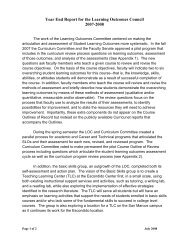

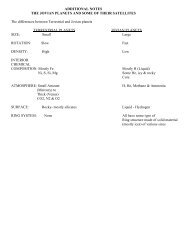
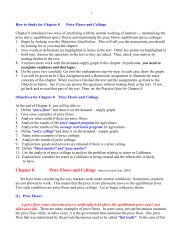
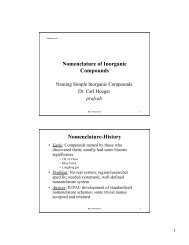
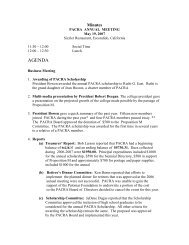
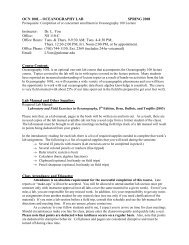
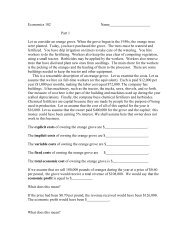
![Ch. 3 [pdf]](https://img.yumpu.com/49528659/1/190x245/ch-3-pdf.jpg?quality=85)
